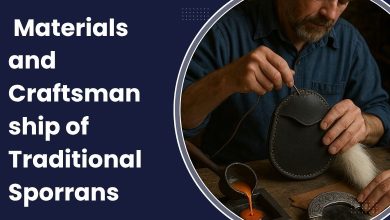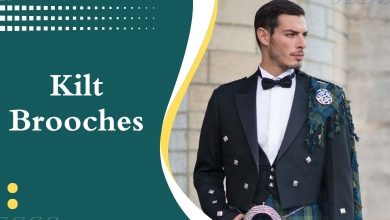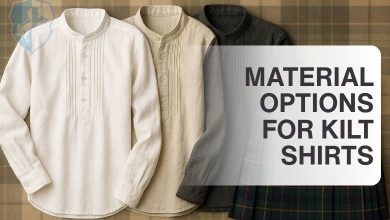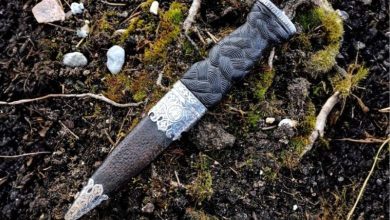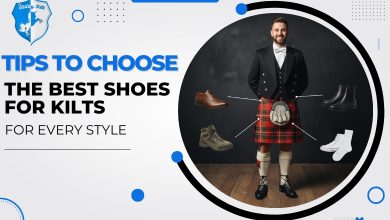The Kilt Belt and Buckle: A Symbol of Scottish Tradition
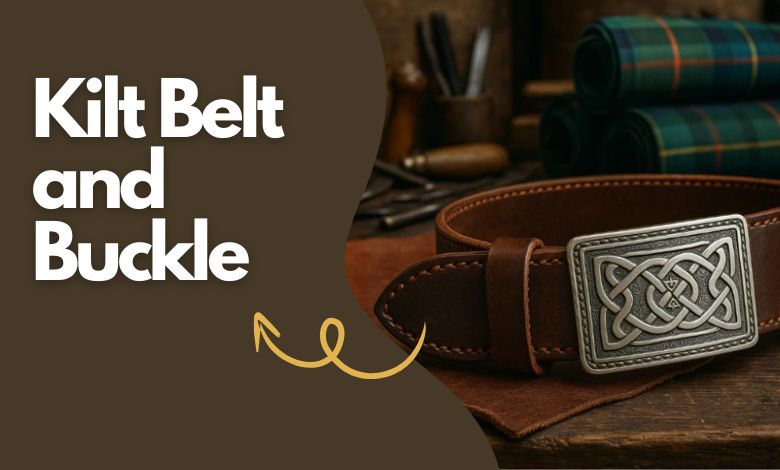
Every component of a kilt outfit is important and works as a way to honor the heritage. The same story is true of the kilt belt and buckle since they are collectively cultural and practical items. A popular one of them, kilt belts, has different variations and is made with several materials. Similarly, the buckles connecting both ends of the belt have traditional designs, and they admire the Highland culture. So, without further delay, let’s start our discussion by understanding the differences between kilts and standard belt buckles.
Table of Contents
ToggleKilt Belts vs. Regular Belts: Key Differences
People consider both Scottish and standard belt variations to be similar. The naked eye may also confuse them with visuals. Until a person is unaware of the differences, it occurs constantly. Here are a few distinctions.
| Kilt Belt & Buckle | Standard Belt & Buckle |
| Wide, thick leather belt, often 2.5-3 inches or more | Narrower, typically 1-1.5 inches wide; simple and functional design; buckle is usually plain and small |
| decorated with Celtic or traditional Scottish motifs; buckle usually large and ornamental | Everyday use for holding up pants or jeans; designed for practicality and comfort |
| Worn with traditional Scottish attire to support heavy kilt fabric and add aesthetic value to Highland dress | Usually thinner leather, fabric, or synthetic materials for flexibility |
| Heavy, sturdy leather for durability and strength; sometimes embossed or tooled | Adjustable via holes or ratchet mechanisms, designed for daily wear and easy adjustment |
| Larger buckles with traditional or Celtic designs, sometimes polished metal or antique finish | Functional buckles in various shapes, mostly plain metal |
| Strong cultural and ceremonial importance; part of Scottish heritage | Mainly utilitarian, with no particular cultural symbolism |
Types of Kilt Belts and Buckles: A Complete Breakdown
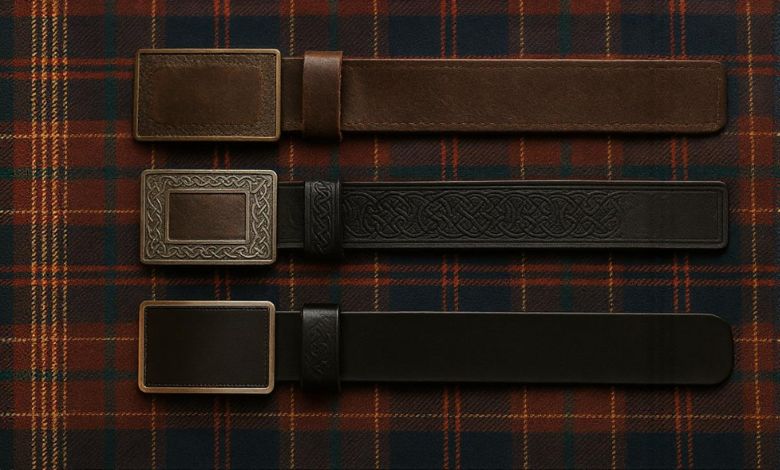
All the belts may sound the same because of their construction with the leather, whether they are kilt leather belts or regular belts. Therefore, many things reveal their differences, from their width to material and designs. For convenience, we selected a few kilt belt variations.
Leather Kilt Belt
This is the most traditional type of kilt belt that Scots have been using for centuries. Such belts are made with pure, extraordinary leather quality. Serving as the key component of attire, they seem to be sturdy, wider, and comfortable ones. Their rugged structure even helped to bear the weight of traditional Great kilts.
Embossed Kilt Belt
Traditional kilt accessories with raised patterns or designs on the leather surface are called embossed kilt belts. Usually constructed from hide leather, they are 2.25 inches wide and intended to be worn over the kilt’s belt loops. Frequently, these belts are worn with a kilt buckle
Plain Kilt Belt
The next variation of the belt to be attached to traditional Highland dress is the plain one. It has plain visuals with no designs or ornaments. Similarly, the buckle is also simple. Attaching or not wearing them depends on the theme of events since they are not an everyday wear with Scottish attire.
Materials and Craftsmanship Behind Kilt Belts and Buckles
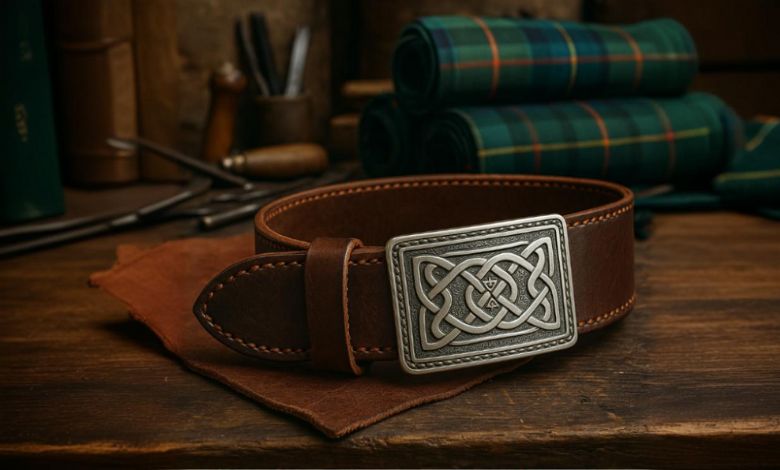
When it comes to the mediums of kilt belts and buckles, industries ensure using premium-quality materials because of their connection with a thousand-year-old tradition. This is why premium-quality leather variations like full-grain and top-grain are the top choices. Buckles’ material, on the other hand, has a little flexibility. Several variations, including brass, pewter, or chrome, make buckles today.
Another point here is the craftsmanship behind the construction of such objects. Many might know that traditional men’s kilts and tartans are still made by hand for strict formal events and for those who prefer sticking to their culture. Scots make belts and buckles using age-old methods that have been passed down through the generations.
Kilt Belt and Buckle Sizing Made Simple
The size of a kilt belt depends on the size of the wearer. Its width ranges from 2 to 2.5 inches, while the same applies to the buckle. However, the length of the belt relies on the body shape and if the wearer has a thick or thin stature. Here is the table to make decisions easily.
| Body Shape | Waist Size | Recommended Belt Size |
| Slim/Thin Build | 28–32 | 34–36 |
| Average/Regular | 33–36 | 38–40 |
| Broad/Athletic | 37–40 | 42–44 |
| Heavy/Thick Build | 41–46 | 46–50 |
| Plus Size | 47–54+ | 52–58 |
How to Wear Your Kilt Belt and Buckle the Right Way
Wearing kilt accessories correctly means respecting it, regardless of what part it is. The same is true of the kilt buckle and belt. Therefore, the important thing in this scenario is their correct placement. Follow the given steps for them accurately.
- Start by wearing a kilt in a way that the fringes are on the right side and the pleats are at the back, and then wrap the kilt around your waist.
- Insert the thin end of the kilt belt into the buckle.
- When you wrap the belt around your waist, make sure the buckle is in the middle.
- To fasten the belt, fold the end back on itself and fasten it with the small buckle on the inside. Another option is to attach the main buckle to the belt’s opposite metal loop.
- The kilt should be comfortable, and it should sit high on your waist just above your belly button.
- A belt buckle should be in the same center as the sporran on the front of the kilt.
- Before tying the belt, clip the chain straps to the back of the sporran after looping them through the belt’s loops.
- At last, ensure your waistcoat and jacket fit properly and that the belt buckle, sporran, and kilt all line up.
How to Choose a Kilt Buckle That Reflects Your Style
Whether it is a dress or any of its components, the choice of anything reveals a lot about the buyers’ personalities. Scottish dress and kilt accessories follow the same criteria too. So, whenever opting for a buckle, consider a few things like its material, the event to wear it to, and the personal preferences of the wearer.
Do not buy a quality-compromised product, whether you need one for a casual or a formal event. Similarly, if the event is a strictly formal one, give a thought to buying one with Celtic or traditional designs to honor the heritage. The last but most important point is the comfort and secure fitting of the buckle. Choose that product instantly if it fulfills all of these requirements.
Common Symbols and Clan Crests in Buckle Design
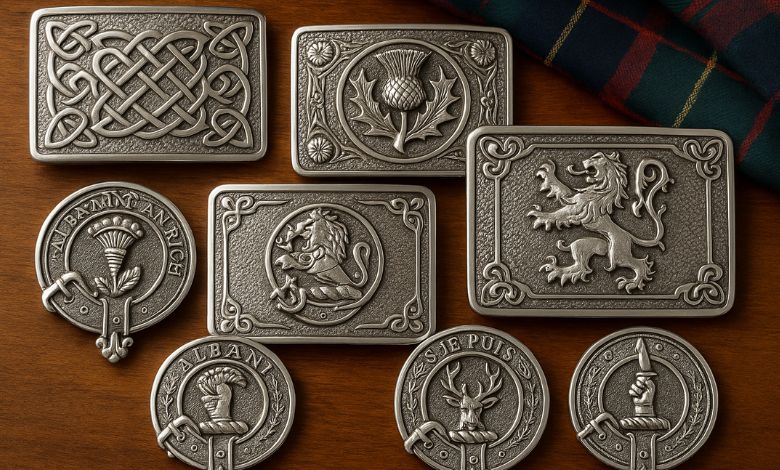
While choosing a kilt buckle, one must know how to express his connection with his heritage. The best way to do so is to purchase the one with traditional Celtic or Scottish symbols. Some worth considering popular engraved designs are:
Celtic Knots: These knots traditionally connected to Celts are a kind of ornamental knot that symbolizes eternity and interconnectedness with its continuous, looped design that has no beginning or end.
Thistle: The Scottish thistle, the national flower of the country, is often engraved on kilt belt buckles. It is a much-loved design by people who feel pride in showing their connection with their country. This symbol is common to spot at formal events where Scots usually show their love for their homeland.
Lion Rampant: Though a sign of royalty in Scotland, Lion Rampant is another sign that buckle wearers can consider. This symbol contains a lion, and Scots have been using it since the 12th century. Therefore, its use on buckles has become popular for a few decades.
Clan Crest: Clan crests are frequently featured on kilt buckles as a means for people to show off their ancestry or clan affiliation. Each clan has its own crest, and anyone associated with a clan is permitted to wear it.
Styling Tips: Matching Belts, Buckles & Kilts
A well-matched belt, buckle, and kilt will keep your Highland look polished and dignified. Don’t combine an overbright buckle with a plain kilt; instead, choose a belt and buckle that complement the color and style of your kilt. For a more formal kilt, choose designed buckles featuring Celtic or clan patterns. Casual kilts look fantastic with plain belts. Instead of pairing silver buckles with gold sporrans, make sure the metal finishes match. By maintaining order and harmony, you can show that you take pride in the Scottish custom.
Best Place to Buy Kilt Belts & Buckles Online (2025 Guide)
Now that you know different types of kilt belts and buckles, how to wear them, and styling tips for several events, it’s time to find a perfect one to pair with your kilt. To do so, you need to fulfill your requirements by choosing an exceptional online brand, and none other than The Utility Kilt is better. We are known for providing excellent quality with exceptional customer dealing services. We also offer excellent exchange and return policies that most online brands do not!
Frequently Asked Questions
What function do belt buckles have?
Should I wear a kilt belt with a sporran?
Yes, you can wear a kilt belt with your sporran. Both of them have different uses, which is why there is nothing wrong with pairing them both at a time.
What’s the difference between a kilt buckle and a regular belt buckle?
A kilt buckle is designed specifically for the unique way a kilt belt is worn and secured, while a regular belt buckle is used for more general belt applications. Kilt buckles often feature more decorative designs and thicker widths. Regular belts, on the other hand, are smaller, simpler, and attached to pins.
Can I wear a kilt belt and buckle for casual events?
Absolutely, you can wear a kilt belt and buckle at casual events. Though the trend sounds more prominent in formal or semi-formal settings, there is no strict rule for casual events.
